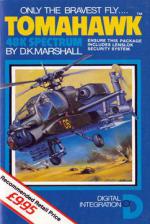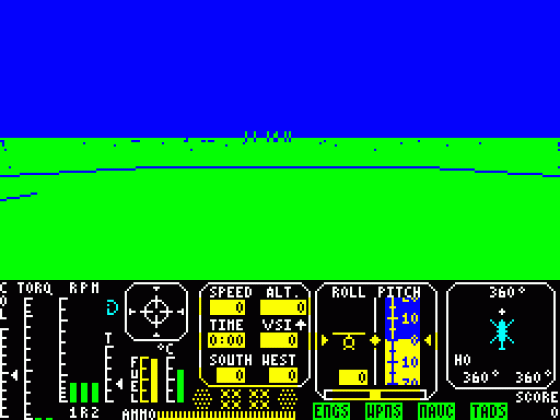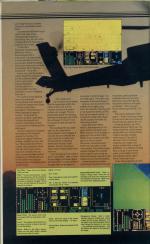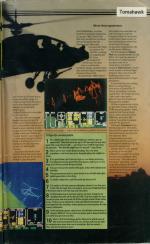
Sinclair User
 15th December 1985
15th December 1985
Categories: Review: Software
Published in Sinclair User #47
Chris Bourne plucks up the courage for a spin in the war machine
Tomahawk
Flight simulation enthusiasts need no introduction to Digital Integration, publishers of Fighter Pilot, which has been acclaimed as far and away the best simulation of a conventional aircraft on the Spectrum market, with its dogfight options and realistic controls.
Since then, programmers Dave Marshall and Rod Swift have been quietly working on Tomahawk, a simulation of the USAF Apache helicopter, as vicious a beast as ever darkened the skies of modern war.
The first thing you notice about Tomahawk - and if you don't Dave will point it out soon enough - is the staggering amount of detail on the screen. Trees, mountains, artillery, tanks, buildings, pylons - all picked out in wireframe graphics which, while at times may seem distorted, are nevertheless well in advance of anything you've ever seen before on a simulation.
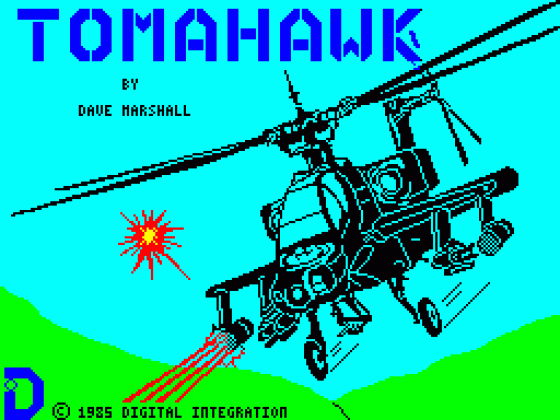
"A helicopter is quite slow," says Dave, "but it's designed to fly low. 150kts at ten feet is quite exciting, so we needed to have ground content to simulate speed." After some false starts, he decided on a pattern of dots which stream towards you as you fly, and which you can visualise as small bushes or hummocks.
They tend to confuse you when searching for targets on the horizon, which also look like small dots - you are thus forced back on your instruments for accurate information, as a real pilot would be.
Apart from the usual training mode, where nothing fires at you - although the enemy helicopter will play a kamikaze role and attempt to collide with you - the program includes several options for games of varying length. The full version is played across the whole of the map. Some of the squares you control, others are controlled by the enemy, and you must drive the enemy out of those while making sure he doesn't overrun your own territory in the process. Since each square contains eight ground targets, that's a long haul.
"Rod cleared the whole thing the other day," says Dave, awed. "That was about 200 tanks, 200 field guns and about eight helicopters I think."
Rod sits back and looks very smug.
Dave prefers option two, where you have to clear just four squares of map. He says the record is about 22 minutes, though he clearly hasn't reckoned with the godlike skills of Sinclair User readers. How about it, guys? Anyone done better than that yet? And how about the masochist's delight - clearing the whole of the map from just one sector? Dave reckons that takes about twenty hours.
"You start suffering from battle fatigue eventually," says Rod. "After all, real pilots would only be airborne for two-and-a-half to three hours."
For real horrors, try flying at night - and with cloud cover, which means, at the toughest option, that you can't see anything unless you're low enough to collide with it. The night option blots out the horizon so that all you can see are the outlines of the features and those hypnotic dots. It becomes difficult tell whether you're upside down or flying level or crashing towards the ground. It becomes difficult to do anything at all except gibber and dribble and die, smashed into fifty thousand pieces against the side of a mountain.
"Slowing down is the biggest problem," says Dave, helpfully. "In a real helicopter it would take you about two miles." One way of slowing down is to stick the nose up in the air, which is fine but tends to gain height. It would, wouldn't it? And if you're too high to see your targets, you have to dive, and then you gain speed, and before you know where you are you've ripped your rotor baldes off. C'mon Dave, there's got to be an easier way of making the world safe for democracy.
"Look," says Dave, infuriatingly clam. "Most people try to control an aircraft with the joystick alone, but you have to use both throttle and stick." Right, so the throttle controls your speed and the joystick sends you up and down, OK?
"Wrong. The throttle your height and you use the joystick to accelerate or slow down."
Just when we thin we've got used to that idea, Dave introduces the subject of turbulence. Yes, you can inflict crosswinds and turbulence on yourself, if you want.
"In real life a helicopter behaves quite differently from a fixed-wing aircraft in turbulence. You experience a visual oscillation but as you've got a weight hanging below your rotors you're much more stable. Don't fight the turbulence - let it ride."
In fact, as in real life, below a certain height the turbulence and wind have no effect at all, so you could always drop down into the calm if you find yourself in trouble. Only then it's pylon-dodging time again...
The stability of the Apache, which has advanced computerised auto-stabilisers, is one of the reasons why Dave and Rod chose it for a simulation in the first place. In effect, because it's easy to control. "It was the first problem we had," says Dave. "Initially the Apache isn't actually controllable. A pilot could never fly it without all the stabilisers."
Another reason for choosing the Apache is all the lethal weaponry it carries. The original manages 16 Hellfire missiles, a 30mm cannon and four 19-round pods of 70mm rockets. Dave seemed to think that was a bit much, so the Spectrum version only has eight missiles and two pods of rockets to go with the cannon. On the other hand, you can always land at a helipad to stock up with more.
The rockets and cannon have to be aimed, and the target kept within the sights at all times, but the missiles can be instructed to home in on a target. They're particularly useful for blasting the enemy helicopter out of the sky, although it's much more fun to get in close and use the cannon.
The real Apache has a laser sight on the nose which automatically tracks targets. It can also be controlled by the pilot's helmet, a frightening thing called an Integrated Helmet and Display Sight System. Simply move your head, and the laser sights move with you.
"You can pop up from behind a hill," says Dave, "take a video of your target, pop down again and examine the video to select a target, then go up again to illuminate it with the laser, fire and hide again. The video uses computer-enhanced imagery."
And you can do all that in the middle of the night using infra-red cameras. Fighting with a real Apache is really just like playing a computer game - a comparison with which Dave readily agrees. He thinks it's disturbing as well.
Apart from the helmet fature, the weapons on the game work in the same way. When you zero in on a target, it pops up in the centre of the Range-finder display as a field gun or a tank or enemy helicopter, sometimes well before you can see it on the main screen. The missile target square changes from dotted lines to solid, and as long as that solid square remains on the screen you can fire the missile.
It even words from within cloud cover or behind trees and mountains, although Dave confesses that you can also shoot your guns through the mountains, which is not quite so realistic! "Still, you can't have everything for £9.95," he says.
The enemy helicopter in the game - there's only ever one at a time, but a new one comes on the minute you destroy the old - is not an Apache, you'll be relieved to know. Mind you, it's a brave machine, which always comes after you, and in trainee mode is avtually suicidal, ramming you if you don't attempt to kill it. It always matches your height, and carries rockets with a range of 4,000 feet. Your Hellfire missiles have a range of up to three miles, so the battle if fairly one-sided, but then again, there's only one of you.
Given the propensity of tanks and artillery to fire back at you whenever within range, it's amazing how much damage a well-piloted Apache can do. I was less surprised after watching the Hughes-McDonnell sales video for the real thing.
The sight of a camouflaged Apache rearing up over the crest of a hill like the Indians of old, to blast tanks in the Arizona desert is awe-inspiring. As the syrupy commentary - as nasty a piece of war glorification as I've ever heard - points out, "It is a whimsical thought that the Battle of the Bulge could have been won with two Apaches armed only with Hellfire missiles".
Doubtless the whole of the Second World War could have been won with six. If you don't believe it, play the game.
10 Tips For Novice Pilots
- For a flash take-off in combat mode, you want to get up speed fast. Take the controls up to 100 per cent torque and push the nose down to 30 degrees - you'll go from 0-100 in less than six seconds. "Not bad for eight tons of aircraft," says Dave.
- Don't worry too much about landing. You can land anywhere, and then taxi up to the pad using the rudder to steer.
- It's a good idea not to be too high or low when attacking. You always have to point the nose down, and if you're too high you'll find yourself diving too fast.
- You can't shoot the tanks with guns, only with rockets and missiles.
- The conventional way to slow down is to roll left and right, which generates more drag.
- To make a right turn, pull the nose up as you roll.
- It's easier to hit the enemy helicopter when it's on the turn. It can't fly through the mountains, so if you sit behind them it'll have to come over the top and then dive.
- At the beginning of a proper game, set your weapons to missiles and take off to above 512ft. Use the rudder to turn round on your axis and pick off all the targets under three miles away. Then you can descend to the pad directly beneath you and replenish the missiles, which gives you some spares for the enemy helicopter.
- In the strategy game, option four, the division of territory is always different. If you want an easier game, keep breaking out until you get one you like.
- Also in the full strategy game, take out a whole row of the enemy positions if you can, as they will not be able to recapture any once the row is complete. But be careful - they can do the same to you!
About The Programmers
Dave Marshall and Rod Swift formed Digital Integration in January 1982. At the time they both worked for the Royal Aircraft Establishment at Farnborough. Dave was involved with flight simulations for the RAF, working on adapting US Air Force simulators for British use. Rod was more involved with hardware design, and the initial idea was that Digital Integration should produce both.
By September 1983, most of their spare time was taken up with running DI, and they chucked in their full-time jobs, preferring to make money on their own account rather than remain part of a large, bureaucratic organisation like the Ministry of Defence.
The first version of Fighter Pilot was actually written for the ZX81, but it was the launch of the Spectrum which saw the company take off, in conjunction with Rod's program Night Gunner, a much more arcade-orientated flight program. Dave says he's still working on even more advanced techniques for flight simulators.
In love with big motorcycles, Rod is currently doing a simulation of Grand Prix TT racing, simulating a monster Suzuki bike. The screen will be a "rider's eye" view, with a genuine race and mysterious new graphics system.
All the programming is done on two CAL micros, under the CP/M Operating System. Dave explains that that particular micro, while using the 16-bit 6088 chip, also has a Z80 making it possible to prepare code for the Spectrum.
Although Tomahawk is the first DI product for eighteen months, Dave and Rod swear they won't take anything like as long over the next one. More programmers have been employed, and the results, if promises are anything to go by, should be spectacular.
Neither admit to any regrets in giving up the world of professional aviation for writing entertainment software. Well, maybe one. "I do miss one of the perks," says Dave. "I used to get the chance to fly RAF combat aircraft occasionally. It would be nice to spend more time in the air again."
This article was converted to a web page from the following pages of Sinclair User #47.

